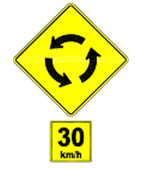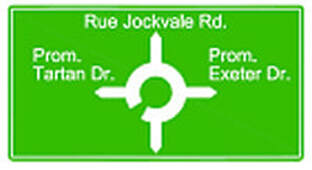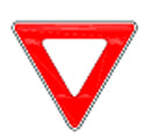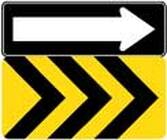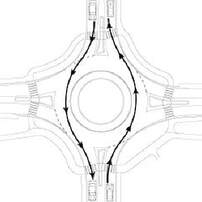What is a Roundabout?
A modern roundabout is a circular intersection that does not have traffic signals. It is designed to maximize safety and minimize traffic delay.
Key features
Adapted from Federal Highway Administration, Roundabouts: An Informational Guide, Report No. FHWA -RD-00-067, June 2000
Traffic Flow
Signs
A modern roundabout is a circular intersection that does not have traffic signals. It is designed to maximize safety and minimize traffic delay.
Key features
- Central island: A raised area in the centre of a roundabout around which traffic circulates.
- Splitter island: A raised or painted area on an approach used to separate entering from exiting traffic, deflect and slow entering traffic, and provide storage space for pedestrians crossing the road in two stages.
- Circulatory roadway: A curved path used by vehicles to travel in a counter-clockwise direction around the central island.
- Truck apron: If required on smaller roundabouts to accommodate the wheel tracking of large vehicles, an apron is the mountable portion of the central island adjacent to the circulatory roadway.
- Yield line: Pavement marking used to mark the point of entry from an approach into the circulatory roadway; is generally marked along the inscribed circle. Entering vehicles must yield to any circulating traffic coming from the left before crossing this line into the circulatory roadway.
- Pedestrian crossings: Set back from the yield line and the splitter island to allow pedestrians, wheelchairs, strollers and bicycles to pass through.
Adapted from Federal Highway Administration, Roundabouts: An Informational Guide, Report No. FHWA -RD-00-067, June 2000
Traffic Flow
- Low speed on approach
- Approaching vehicles yield to traffic already in the roundabout
- Vehicles drive counter-clockwise and always to the right of the central island
- Low speed on exit
- Continuous movement of traffic
Signs
For more information on roundabouts, download Navigating Roundabouts PDF opens in a new tab or window [PDF – 432 KB] or e-mail [email protected]
How to use a roundabout
Starting in June 2016 Pedestrian Crossovers will be situated at warranted locations throughout the city, These locations will include most single lane roundabouts. At roundabouts where Pedestrian Crossovers are being installed, pedestrians will now have the right of way over vehicles. For more information on Pedestrian Crossovers, please refer to the Pedestrian Crossover website
PedestriansRoundabouts are often safer for pedestrians than intersections that use traffic signals. At a roundabout, a pedestrian only has to cross two sections of one-way traffic, which is moving at slow speeds. A pedestrian crossing at an intersection with signals must deal with vehicles turning right or left on green, and turning right on red. Some vehicles run the red light, which may result in injuries or fatalities for pedestrians.
At a roundabout:
How to use a roundabout
Starting in June 2016 Pedestrian Crossovers will be situated at warranted locations throughout the city, These locations will include most single lane roundabouts. At roundabouts where Pedestrian Crossovers are being installed, pedestrians will now have the right of way over vehicles. For more information on Pedestrian Crossovers, please refer to the Pedestrian Crossover website
PedestriansRoundabouts are often safer for pedestrians than intersections that use traffic signals. At a roundabout, a pedestrian only has to cross two sections of one-way traffic, which is moving at slow speeds. A pedestrian crossing at an intersection with signals must deal with vehicles turning right or left on green, and turning right on red. Some vehicles run the red light, which may result in injuries or fatalities for pedestrians.
At a roundabout:
- Look and listen for approaching traffic. Choose a safe time to cross from the curb ramp to the median opening.
- Walk on the sidewalk/path at all times.
- Never cross the circular roadway to the central island.
- Cross at the designated crosswalk.
- Look in the direction of the oncoming traffic and wait for an acceptable gap before entering the crosswalk.
- Proceed to the splitter island (median) and use as a refuge. Look in the direction of oncoming traffic and wait for an acceptable gap before crossing.
- Ride as if operating a motor vehicle — at the same speed. When riding in a bike lane or on the shoulder, merge into the travel lane before the bike lane shoulder ends. Obey the same driving instructions as vehicles. It is generally safest to claim the lane. Don't hug the curb, ride close to the middle of the lane and be cautious of drivers' blind spots.
- Dismount and use sidewalks and crosswalks. Some roundabouts have a ramp that leads to a shared bicycle–pedestrian path, which runs the perimeter of the roundabout. If there is no shared path, obey the signs, dismount and walk your bicycle.
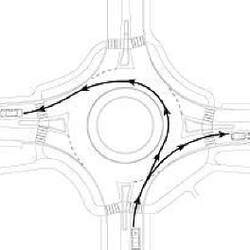
Making a right turn
Making a left or U-turn (exiting more than halfway around the roundabout)
- Unless posted otherwise, use the right lane if there are multiple approach lanes and turn on the right-turn signal.
- Reduce your speed.
- Keep to the right of the splitter island.
- Allow cyclists to enter the roadway in front of you.
- Watch for pedestrians in the crosswalk or waiting to cross. Be prepared to stop if a pedestrian is already in the crosswalk.
- Move up to the yield line and wait for an acceptable gap in traffic. Do not enter next to someone already in the roundabout, as that vehicle may be exiting at the next exit. (If another vehicle is stopped at the yield line, do not stop on the crosswalk. Keep the crosswalk clear for pedestrians).
- Enter the roundabout when there is an adequate gap in traffic within the circular roadway.
- Within the roundabout, do not stop except to avoid a collision; you have the right-of-way over entering traffic. Keep to the right of the central island and travel in a counter-clockwise direction.
- Do not overtake other vehicles and cyclists.
- Keep to the outside of the circulatory roadway within the roundabout and continue to use your right-turn signal as you exit. If there are multiple exit lanes, use the right-hand lane.
- Maintain your slow speed until you have passed the crosswalk. Watch for pedestrians in the crosswalk or waiting to cross and cyclists on the road as you exit.
Making a left or U-turn (exiting more than halfway around the roundabout)
- Follow the same steps from 1 to i (see above).
- When you have passed the last exit before the one you want, use your right-turn signal and continue to use your right-turn signal through your exit. Maintain a slow speed.
- Watch for leading or adjacent vehicles on the outside (for multi-lane roundabouts) that continue to move around the roundabout.
|
Moving straight through
|
Large vehicles
When approaching a roundabout, do not overtake large vehicles (trucks and buses) and give them plenty of room. They may have to swing wide on the approach or within the roundabout.
Emergency vehicles
If you are in a roundabout when an emergency vehicle is approaching, proceed to beyond the splitter island of your exit before pulling over to the right and stopping. Do not stop in the roundabout. If you haven't entered the roundabout, wait until the vehicle has passed before entering.\
Driving a truck
You may need to use the full width of the road. Signal your intentions well in advance and make sure that other users are aware of you. Stay close to the left side of the entry. As you exit, again stay close to the left side of the exit.
Tips for two-lane roundabouts
Turning left
Turning right
Navigating roundabouts
The City of Ottawa is installing more and more roundabouts. Roundabouts are actually pretty simple to use and, more importantly, safer than traditional intersections. Because navigating roundabouts is new to many residents of Ottawa, the following information will help steer you in the right direction.
Car Turning Left
When approaching a roundabout, do not overtake large vehicles (trucks and buses) and give them plenty of room. They may have to swing wide on the approach or within the roundabout.
Emergency vehicles
If you are in a roundabout when an emergency vehicle is approaching, proceed to beyond the splitter island of your exit before pulling over to the right and stopping. Do not stop in the roundabout. If you haven't entered the roundabout, wait until the vehicle has passed before entering.\
Driving a truck
You may need to use the full width of the road. Signal your intentions well in advance and make sure that other users are aware of you. Stay close to the left side of the entry. As you exit, again stay close to the left side of the exit.
Tips for two-lane roundabouts
Turning left
- Be in the left lane and put on your left indicator as you enter the roundabout.
- Stay in the left lane as you enter the roundabout.
- Indicate a right turn as you approach your exit.
- Stay in the left lane as you exit the roundabout.
- Be in either lane. You do not need to use an indicator to go straight ahead as you enter the roundabout.
- Stay in the same lane as you enter the roundabout.
- Indicate a right turn as you approach your exit.
- Stay in your lane as you exit the roundabout.
Turning right
- Be in the right lane and put on your right indicator as you enter the roundabout.
- Stay in the right lane as you enter the roundabout.
- Keep your right indicator on until you have exited the roundabout.
- Stay in the right lane as you exit the roundabout.
Navigating roundabouts
The City of Ottawa is installing more and more roundabouts. Roundabouts are actually pretty simple to use and, more importantly, safer than traditional intersections. Because navigating roundabouts is new to many residents of Ottawa, the following information will help steer you in the right direction.
Car Turning Left
- Yield to all traffic in all lanes of the roundabout. Do not enter beside a driver already in the roundabout.
- Stay in the inner lane as you pass the first and second exits.
- As you approach the third exit, signal right.
- Signal right.
- Yield to all traffic in all lanes of the roundabout. Do not enter beside a driver already in the roundabout.
- Stay in the outer lane, signal right and exit at the first exit
- These lane signs say that you can use either lane. Do not signal because you are going straight through.
- Yield to all traffic in all lanes of the roundabout. Do not enter beside a driver already in the roundabout
- Stay in the inner or outer lane as you pass the first exit.
- As you approach the second exit, signal right.
- Exit from the inner lane into the left lane or from the outer lane into the right lane.
- Signal left.
- Yield to all traffic in all lanes of the roundabout. Do not enter beside a driver already in the roundabout.
- Stay in the inner lane as you pass the first three exits.
- As you approach the fourth exit, signal right.
- Straddle the entry lanes and signal left.
- Yield to all traffic in all lanes of the roundabout. Do not enter beside a driver already in the roundabout.
- Use both lanes in the roundabout as you pass the first and second exits. Do not try to keep to one lane so that other drivers can pass you.
- As you approach the third exit, signal right.
- Signal right.
- Yield to all traffic in all lanes of the roundabout. Do not enter beside a driver already in the roundabout.
- Signal right and exit at the first exit.
- Straddle the entry lanes. Do not signal because you are going straight through.
- Yield to all traffic in all lanes of the roundabout. Do not enter beside a driver already in the roundabout.
- Use both lanes in the roundabout as you pass the first exit. Do not try to keep to one lane so that other drivers can pass you.
- As you approach the second exit, signal right.
- Straddle the entry lanes and signal left.
- Yield to all traffic in all lanes of the roundabout. Do not enter beside a driver already in the roundabout.
- Use both lanes as you pass the first three exits. Do not try to keep to one lane so that other drivers can pass you.
- As you approach the fourth exit, signal right.
- Start in the right lane.
- Yield to all traffic in all lanes of the roundabout. Do not enter beside a driver already in the roundabout
- Stay in the outer lane as you pass the first exit. Ride in the middle of the lane. Don't hug the curb.
- As you approach the second exit, signal right.
- Exit from the outer lane into the right lane.
- Use the ramp that leads to the sidewalk.
- Dismount and walk your bicycle.
- Use the sidewalks and crosswalks around the outside of the roundabout. Do not cut across the middle of the roundabout.
- Point your finger across the crosswalk to say to drivers you intend to cross. Look and listen for a safe gap in traffic.
- Step up to the curb. Look at the drivers. You decide when to step out and go.
- Start to cross as soon as you are sure the driver intends to slow or stop to yield the crosswalk to you.
- Watch for a driver coming in the next lane. Make sure that the driver sees you.
- Keep watching all the way across.
- Wait on the splitter island for a safe gap in traffic before crossing to the other side of the road.
- Step up to the curb. Keep pointing your finger across the crosswalk to say to drivers that you intend to cross.
- If you have not yet entered the roundabout, pull to the right and let the emergency vehicle pass you.
- If you are already in the roundabout, do not stop in the roundabout because the emergency vehicle may not be able to get by you. Continue on and exit as normal.
- Do not enter a roundabout when an emergency vehicle is approaching.
- After you have exited the roundabout, pull to the right where there is room for the emergency vehicle to pass you.
- This driver should have yielded to the driver in the inner lane.
- This driver should be in the inner lane to make a left turn.
- This driver should have signalled right for the next exit.
- This driver should have given the large truck more space.
- This driver should have exited into the right lane.

